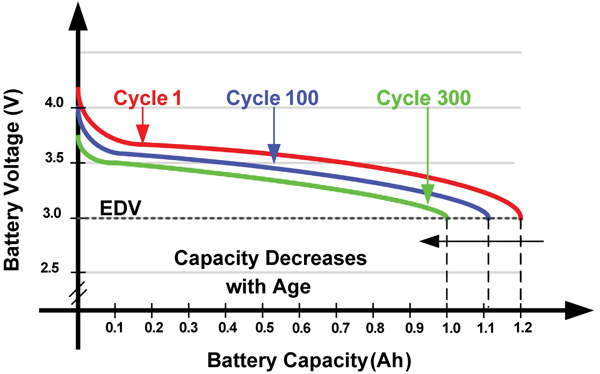Apple Confirms CPU Limitation In Ageing Devices
by Andrei Frumusanu on December 21, 2017 7:18 AM EST- Posted in
- Mobile
- Apple
- Smartphones

Over the last week there's been increasing discussion and evidence of Apple's supposed introduction of CPU throttling mechanisms directly related to the battery wear level on Apple iPhones. The story started out with a report on Reddit of a user experiencing slow performance on an iPhone 6S and subsequent discovery that the performance restored to its full potential after a battery replacement.


Graph credit: John Poole, GeekBench 4 Blog
The report prompted GeekBench author John Poole to make use of the GeekBench benchmark submission database to plot performance of individual devices against iOS versions and discover a clear trend of ever increasing distribution towards lower performance points with newer OS versions.
Matthew Panzarino from TechCrunch was able to get an official statement from Apple when enquiring about the problem:
Our goal is to deliver the best experience for customers, which includes overall performance and prolonging the life of their devices. Lithium-ion batteries become less capable of supplying peak current demands when in cold conditions, have a low battery charge or as they age over time, which can result in the device unexpectedly shutting down to protect its electronic components.
Last year we released a feature for iPhone 6, iPhone 6s and iPhone SE to smooth out the instantaneous peaks only when needed to prevent the device from unexpectedly shutting down during these conditions. We’ve now extended that feature to iPhone 7 with iOS 11.2, and plan to add support for other products in the future.
Apple’s official statement sheds some light into the issue but comes short of an actual technical explanation of why the power management is failing. The company claims that the issue at heart is because of the battery degradation and its inability to supply sufficient current at a stable voltage.

Graph credit: Electronic Component News
Capacity and supply voltage of a battery decreases over time as a function of charge cycles and charging behaviour (Higher charging currents causing more degradation per cycle). This causes the total useable battery capacity before the cut-off voltage to decrease.
The problem facing the iPhones as Apple explains it is however two-fold; the issue at hand happens only during load spikes in which the battery isn’t able to maintain a high enough voltage for the PMIC to reliably be able to use as a source.

Graph credit: Electronic Component News
SoC blocks such as CPUs and GPUs can have very short transitions from idle to load causing steep transients and load spikes going above the +10W ranges. As batteries degrade over time and the cell impedance also rises also in function of the state of charge and temperature, the current flow becomes restricted and the cell is no longer able to satisfy the power requirement at a high enough operating voltage.
Apple’s approach to the issue is to limit the peak power spikes by reducing the CPU frequencies over time as a function of battery wear. This solution however raises several questions; how does Apple decide the throttling behaviour and was the core fault an engineering fault or design choice?
As demonstrated in John Poole’s dataset Apple is throttling the CPU frequency in several stages. What exactly defines the thresholds to reach these stages can be either a rather simplistic counter taking into account the charge cycles of a given battery, or (and more hopefully) a more dynamic method that would be able to take advantage of the battery PMIC’s capabilities of determining battery wear. Given however that it seems that the OS is limiting performance even at high state of charges, such as fully charges batteries, it seems that the limitation implementation is unfortunately of the more simplistic type.
The second question comes to regard to as why it came to the issue in the first place as this should be a universal issue affecting a greater number of smartphones, not just Apple iPhones.
The first unique characteristic separating Apple iPhones from other smartphones is that Apple is using a custom CPU architecture that differs a lot from those of other vendors. It’s plausible that the architecture is able to power down and power up in a much more aggressive fashion compared to other designs and as such has stricter power regulation demands. If this is the case then another question rises is if this is indeed just a transient load issue why the power delivery system was not designed sufficiently robust enough to cope with such loads at more advanced levels of battery wear? While cold temperature and advanced battery wear are understandable conditions under which a device might not be able to sustain its normal operating conditions, the state of charge of a battery under otherwise normal conditions should be taken into account during the design of a device (Battery, SoC, PMIC, decoupling capacitors) and its operating tolerances.
If the assumptions above hold true then logically the issue would also be more prevalent in the smaller iPhone as opposed to the iPhone Plus models as the latter’s larger battery capacity would allow for greater discharge rates at a given stable voltage. This explanation might also be one of many factors as to why flagship Android and other devices don’t seem to exhibit this issue, as they come with much larger battery cells.
While much of the latter part of this piece is just my personal conjecture as to the deeper causes of the problem, it is clear that this is a larger issue for Apple that has no simple solution (beyond replacing the battery). How this affects more recent devices such as the iPhone 8 and iPhone X, or verifying if indeed the Plus variants would be less prone to the problem is something that will require a lot of testing, collaboration and data collection over longer periods of time.










122 Comments
View All Comments
Jon Tseng - Friday, December 22, 2017 - link
Nope. Thought not.After all let's not let figuring out some basic context get in the way of a good argument..
watzupken - Monday, December 25, 2017 - link
While it sounds sensible to throttle the device to avoid the sudden shutdown, Apple could have been forthcoming about it. People can then decide if they would like to upgrade their OS. As a 6S user, there is not much of an impact for my usage, but for those that uses it for gaming and such will see a drop in performance. The throttle is very aggressive, since it seems to lose half of the clockspeed.watzupken - Friday, December 22, 2017 - link
I personally feel it is a very dodgy move. It could be done for the benefit of consumers, but why keep it a secret until they are caught doing it? When I buy say an iPhone X because of its performance improvement, I expect it to behave the same after a year or even longer. Based on some investigations I read, the clockspeed is drastically lower after the firmware updates, i.e. 600Mhz vs 1.4Ghz. If it is because of battery life, I think the throttle is way too heavy handed. It almost sounded like a deliberate reduction in performance to entice people to switch. Also, why only on iPhone 6 onwards, and not iPads and older iPhones? All these raises more questions about Apple's intent. Anyway true enough, they are already hit with law suits, which is not unexpected. One less reason to go back to Apple until they fix their shop. There are way too many missteps from them this year and they ought to rethink their strategy in the new year instead of being complacent.OreoCookie - Thursday, December 28, 2017 - link
I don't think this is the case. I have had my iPhone 5 with an older battery die on me (at 50 % charged), and throttling is definitely better than just dying. Neither is in Apple's interests, because it sells iPhones by making customers happy. This whole conspiracy theory makes no sense.Older phones not crashing because the battery can no longer support the energy draw is definitely a bad user experience. But Apple should have been honest and given the user a message: Your battery is old and should be replaced. Because of that, you may see slower performance.
amihart - Sunday, December 24, 2017 - link
What if I get my phone serviced or buy a refurbished phone, or just replace the battery myself? To my knowledge, phones don't have a way of detecting the age of a battery, so this will affect everyone no matter how new their battery is... Even if this were accurate, it seems like a massively sweeping decision for a very minor problem that doesn't even effect hundreds of thousands of users. If Apple's argument is to be believed, those small amount of users would be benefited from less random shut downs of their phone, but they're also at the same time being hurt by a much slower phone and potentially even less battery life since they will spend way more time with the screen on waiting for apps to load. So even the people it's supposed to help are also being hurt at the same time... and then people who get their phone serviced are hurt even more and get no help. Even if you were to believe Apple's argument, this seems like a very poor solution. It should at least be optional, maybe give the user a warning saying "hey your phone is old, get your battery serviced, or enable our feature to improve performance [Yes][No]". If they did that, this argument would be a million times more believable...OreoCookie - Thursday, December 28, 2017 - link
That's not correct, the battery controller knows full well the state of your device's battery. There are plenty of apps with which you can check the health of your battery on iOS devices. I use Battery Life.FunBunny2 - Thursday, December 28, 2017 - link
well. Apple could have done what some others have done: write the OS with switches so that "new" functions that don't exist in old phones are walled off. old phones get security code, but not non-functional function code. but, of course, that would mean old phone remain just as usable as before.Tim: "don't you dare do that!!"
vladpetric - Thursday, December 28, 2017 - link
If that's not a good argument for mandating replaceable batteries, I don't know what is :)OreoCookie - Thursday, December 28, 2017 - link
Why not let the customer decide? Most Android phones don't have user replaceable batteries either. Personally, I hope this will push cell phone manufacturers to make battery replacements a more normal occurrence, and to remind customers that batteries don't live forever.Albertc - Friday, December 29, 2017 - link
"As batteries degrade over time and the cell impedance also rises also in function of the state of charge and temperature.."For lithium-ion polymer battery, the cell impedance is very stable as the battery ages. That may be why LG and Samsung say they are not throttling the clocks like Apple is doing.